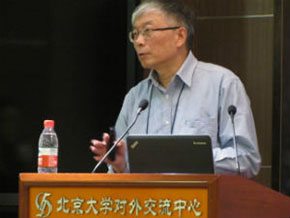

Researchers at Peking University estimate global emissions from 1960 to 2030 and carcinogenic potential of polycyclic aromatic hydrocarbons (photo: H.Shimizu)
Researchers at Peking University estimate global emissions from 1960 to 2030 and carcinogenic potential of polycyclic aromatic hydrocarbons.
Researchers at Peking University estimate global emissions from 1960 to 2030 and carcinogenic potential of polycyclic aromatic hydrocarbons.

Researchers at Peking University estimate global emissions from 1960 to 2030 and carcinogenic potential of polycyclic aromatic hydrocarbons (photo: H.Shimizu)
By Heitor Shimizu, in Beijing
Agência FAPESP – A group of researchers from Peking University in China has obtained important results in a study of polycyclic aromatic hydrocarbons (PAHs), a type of pollutant.
PAHs, which are among the most toxic persistent organic pollutants (POPs), are produced mainly from incomplete burning of organic matter and fuels such as petroleum byproducts, charcoal and wood. Studies have linked PAHs to cancer risk, and these compounds were listed in the Stockholm Convention on Persistent Organic Pollutants in 2001.
“Expanding our knowledge of PAHs is very important for China and other developing countries. Basically, these organic pollutants are produced in all types of combustion, by any substance that burns,” said Shu Tao, professor and director at the College of Environmental Sciences of Peking University, on Thursday, April 17, the second day of the Brazil-China Symposium for Scientific Collaboration – FAPESP Week Beijing held at the Chinese university. Owing to China’s population and energy structure, PAH emissions are even higher in that country.
Tao and his team have developed a computational model that can calculate emissions of the principal types of PAHs in China and across the globe. The model uses data from several sources – including meteorological, public health and satellite data – and combines smaller models that assess atmospheric transport of compounds, population exposure around the world and the risk of getting cancer, for example.
According to the model used by Tao’s group, although the spatial variability is high, the risk of getting lung cancer is greater in eastern China, which is more urban and industrialized, than in other parts of the country.
The researchers also evaluated genetic susceptibility to the risk of lung cancer, which is linked to polymorphism of genes related to carcinogen metabolism and DNA repair.
“Our group estimated that 1.6% of lung cancer cases in China were due to exposure to PAHs. It seems like a small number, but for a large population such as China’s, we are talking about a significant number,” Tao said.
In a paper published in the journal Environmental Science & Technology, Tao and his team analyzed global emissions of 16 types of PAHs from 69 different kinds of sources.
The researchers’ analysis indicated that, of total PAH emissions throughout the world – the period used for the estimate was from 1960 to 2030 – 6.19% can be classified as carcinogens, and the figure was higher in developing countries (6.22%) than in developed countries (5.73%).
According to the study, the potential for harm to health caused by PAHs is greater in regions with higher emissions of these compounds from anthropogenic sources.
The good news is that PAH emissions from human activity are expected to diminish. Simulations up to the year 2030 indicate a drop in emissions from these pollutants, both in developed countries (46% to 71%) and developing countries (48% to 64% lower).
Republish
The Agency FAPESP licenses news via Creative Commons (CC-BY-NC-ND) so that they can be republished free of charge and in a simple way by other digital or printed vehicles. Agência FAPESP must be credited as the source of the content being republished and the name of the reporter (if any) must be attributed. Using the HMTL button below allows compliance with these rules, detailed in Digital Republishing Policy FAPESP.





